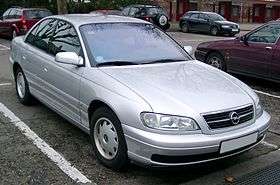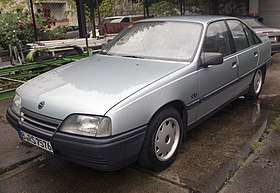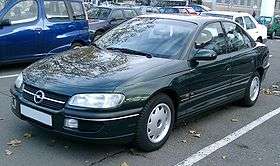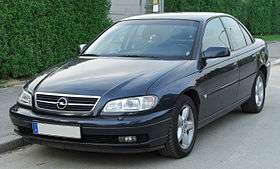Opel Omega
The Opel Omega is an executive car engineered and manufactured by the German automaker Opel between 1986 and 2003. The first generation, the Omega A (1986–1993), superseded the Opel Rekord, was voted European Car of the Year for 1987, and was available as a saloon or estate. The second generation, the Omega B, was manufactured from 1993 to 2003.
| Opel Omega | |
|---|---|
 Opel Omega B2 sedan | |
| Overview | |
| Manufacturer | Opel (General Motors) |
| Production | 1986–2003 |
| Body and chassis | |
| Class | Executive car (E-segment) |
| Layout | FR layout |
| Platform | GM V platform |
| Chronology | |
| Predecessor | Opel Rekord Opel Senator Opel Commodore Vauxhall Carlton |
Rebadged variants of the Omega were marketed worldwide, including in North America as the Cadillac Catera, in Great Britain as the Vauxhall Omega and South America as the Chevrolet Omega. Reengineered versions were manufactured in Australia since 1988 as the Holden Commodore (and its derivatives) since 1999, which were in turn exported to South America as the Chevrolet Omega and the Middle East as the Chevrolet Lumina.
Production of the Omega was discontinued in 2003, with no direct replacement, apart from the Australian reengineered versions that carried on until 2006 as a sedan and 2007 in other guises. After vacating the executive car segment, Opel tried to fill the market void with "expensive" versions of the then existing Vectra and Signum ranges. In the United Kingdom, Vauxhall reentered the market segment in 2007 with the VXR8.
Omega A (1986–1993)
| Omega A | |
|---|---|
 | |
| Overview | |
| Also called | Vauxhall Carlton Chevrolet Omega/Suprema |
| Production | 1986–1993 |
| Assembly |
|
| Body and chassis | |
| Body style | 4-door notchback saloon 5-door estate |
| Related | Holden Commodore (VN) Holden Commodore (VP) Holden Commodore (VR) Holden Commodore (VS) |
| Powertrain | |
| Engine |
|
| Transmission | 4-speed automatic 5-speed manual 6-speed manual (Lotus Omega) |
| Dimensions | |
| Wheelbase | 2,730 mm (107.5 in) |
| Length | 4,687 mm (184.5 in) 4,730 mm (186.2 in) (estate) |
| Width | 1,772 mm (69.8 in) |
| Height | 1,445 mm (56.9 in) 1,480 mm (58.3 in) (estate) |
| Curb weight | 1,150 kg (2,535 lb) |
Development
The original Omega went into production in September 1986, as a replacement for the final version of the Opel Rekord, which had been in production since 1978. Sales began in November. The body was designed as an evolution of the previous Opel design theme engineered more towards aerodynamics in view of higher fuel prices and the general drive towards more fuel efficiency. The result was a remarkable drag coefficient of 0.28 (0.32 for the Caravan). The whole development program cost two billion Deutschmarks. The UK market version of the final generation of Rekord had been marketed as the Vauxhall Carlton, and this nameplate was retained for the new car.
Late in 1986, it was voted European Car of the Year for 1987, ahead of the highly acclaimed new versions of the Audi 80 and BMW 7 Series.[1] Compared to the Rekord, the Omega featured many modern technological advances, which were new to Opel in general, if not to the volume segment European automotive market.
These included electronic engine management, ABS, on board computer (which displayed parameters such as momentary fuel consumption or average speed), air conditioned glove compartment and even the then fashionable LCD instrument cluster (available in CD version from 1987 but dropped in 1991). More importantly, the Omega came with a self diagnose system (which is now a standard feature in present-day cars), whose output could be read by appropriately equipped authorised service stations.
 Opel Omega (1986–90)
Opel Omega (1986–90) Opel Omega (1990–93)
Opel Omega (1990–93).jpg) Opel Omega (1990–93)
Opel Omega (1990–93) Opel Omega Caravan (1990–93)
Opel Omega Caravan (1990–93) Interior
Interior
Engines
All the Omega models used a longitudinally mounted engine with a rear-wheel drive setup, with a five speed manual transmission or four speed automatic transmission. The engine range consisted of 1.8 L, 2.0 L and 2.4 L four cylinder units (as well as 2.0 L, 2.3 L diesel, and 2.3 L turbodiesel) to 2.6 L, 3.0 L, and 3.0 L-24v six cylinder units. The 1.8 L and 2.0 L four cylinder petrol engines were all based on the Family II design, whilst the six cylinder units and the 2.4 L four cylinder were based on the older Opel cam-in-head engine family.
In Brazil, the car was sold as the Chevrolet Omega and powered by 2.0 L I4 (C20NE and C20YE) or 3.0 L I6 (C30NE) Opel engines until 1994. Since the discontinuation of the Omega A in Germany, General Motors do Brasil needed new engines to continue production and the 2.0 L I4 was replaced by 2.2 L I4 engine (C22NE) (116 PS (85 kW; 114 hp), 197 N⋅m (145 lb⋅ft)), and the 3.0 L I6 was replaced by 4.1 L (250ci) Chevrolet Straight-6 engine C41GE (168 PS (124 kW; 166 hp), 285 N⋅m (210 lb⋅ft)), which was tuned by Lotus and equipped with multi port fuel injection. The Chevrolet Omega was produced until 1998.[2][3][4]
| Petrol | ||||
| Engine | Cyl. | Power | Torque | Notes[5] |
|---|---|---|---|---|
| 18NV 1.8i 8V | I4 | 83 PS (61 kW; 82 hp) | 135 N⋅m (100 lb⋅ft) | MY 1986–87 |
| 18SV 1.8 | I4 | 90 PS (66 kW; 89 hp) | 148 N⋅m (109 lb⋅ft) | MY 1986–87 |
| E18NVR 1.8S | I4 | 88 PS (65 kW; 87 hp) | 143 N⋅m (105 lb⋅ft) | MY 1987–90 |
| 18SEH 1.8i | I4 | 116 PS (85 kW; 114 hp) | 160 N⋅m (118 lb⋅ft) | MY 1986–92 |
| C20NEJ 2.0i | I4 | 99 PS (73 kW; 98 hp) | 170 N⋅m (125 lb⋅ft) | MY 1990–93 |
| C20NEF 2.0i | I4 | 101 PS (74 kW; 100 hp) | 158 N⋅m (117 lb⋅ft) | |
| C20NE 2.0i | I4 | 116 PS (85 kW; 114 hp) | 170 N⋅m (125 lb⋅ft) | MY 1986–93 |
| 20SE 2.0i | I4 | 122 PS (90 kW; 120 hp) | 175 N⋅m (129 lb⋅ft) | MY 1986–87 |
| C24NE 2.4i | I4 | 125 PS (92 kW; 123 hp) | 195 N⋅m (144 lb⋅ft) | MY 1988–93 |
| C26NE 2.6i | I6 | 150 PS (110 kW; 148 hp) | 220 N⋅m (162 lb⋅ft) | MY 1990–93 |
| C30LE 3.0i | I6 | 156 PS (115 kW; 154 hp) | 230 N⋅m (170 lb⋅ft) | MY 1986–88 |
| 30NE 3.0i | I6 | 177 PS (130 kW; 175 hp) | 240 N⋅m (177 lb⋅ft) | MY 1986–90 |
| C30NE 3.0Si | I6 | 177 PS (130 kW; 175 hp) | 240 N⋅m (177 lb⋅ft) | MY 1990–93 |
| C30SEJ 3.0i 24V | I6 | 200 PS (147 kW; 197 hp) | 265 N⋅m (195 lb⋅ft) | MY 1990–93 |
| C30SE 3000 24V | I6 | 204 PS (150 kW; 201 hp) | 270 N⋅m (199 lb⋅ft) | MY 1989–93 (Omega 3000) |
| C30XEI 3.0 Evo 500 | I6 | 230 PS (169 kW; 227 hp) | 280 N⋅m (207 lb⋅ft) | MY 1991–1993 (Irmscher for Omega Evo 500) |
| 36NE 3.6i 12V | I6 | 200 PS (147 kW; 197 hp) | (Irmscher) | |
| C36NE 3.6i 12V | I6 | 197 PS (145 kW; 194 hp) | (Irmscher) | |
| C36NEI 3.6i 12V | I6 | 200 PS (147 kW; 197 hp) | (Irmscher) | |
| C40SE 4.0i 24V | I6 | 272 PS (200 kW; 268 hp) | 395 N⋅m (291 lb⋅ft) | MY 1991–92 (Irmscher) |
| C36GET 3.6i 24V | I6 | 377 PS (277 kW; 372 hp) | 557 N⋅m (411 lb⋅ft) | MY 1991–92 (Omega Lotus) |
| Diesel | ||||
| Engine | Cyl. | Power | Torque | Notes[5] |
| 23YD 2.3 D | I4 | 73 PS (54 kW; 72 hp) | 138 N⋅m (102 lb⋅ft) | MY 1986–93 |
| 23YDT 2.3 TD | I4 | 90 PS (66 kW; 89 hp) | 190 N⋅m (140 lb⋅ft) | MY 1986–88 |
| 23DTR 2.3 TD | I4 | 101 PS (74 kW; 100 hp) | 218 N⋅m (161 lb⋅ft) | MY 1988–93 |
Notable trim levels and special variants
The four basic trim levels were LS, GL, GLS and CD (from least to most expensive). The base LS was clearly intended for the fleet market, with the sedan unavailable to individual customers in some markets. The LS Caravan was also available as a panel van with rear side windows covered, with body coloured foil rather than replaced by solid panels.
For the year of 1991, the Omega A was afforded a facelift, which encompassed slight alterations to front and rear fascias, as well as interior materials and additional sound dampening. The until then base 1.8 L engine was dropped. The LS and GLS trim levels were also dropped, while the CD was joined by Club and CD Diamant.
Omega Diamant
This options package was introduced in 1988, and could be added onto the GLS, LS and CD trim version. It included alloy wheels, metallic paint, tinted windows, stereo with cassette player, various leather trim in the interior, as well as a painted grille and door mirrors. It sold well and the package was kept after the facelift and a similar system with the same name was used for the Omega B.[6]
Omega 3000
The Omega 3000 was the sports version of the Omega A model range. It featured a straight-6, 3.0 litre, twelve valve engine, which produced 177 PS (130 kW). Other modifications from the base model included a lowered suspension and limited slip differential, as well as different fascias and a rear spoiler. The car had a top speed of 220 km/h (137 mph), and accelerated from 0–100 km/h in 8.8 seconds. The catalyzed version of the engine originally only had 156 PS (115 kW). The uncatalyzed model was discontinued in August 1988. In countries where the Omega 3000 was sold as a Vauxhall, it was called the Carlton GSi 3000.
In October 1989, the Omega 3000 received an optional new engine with 24 valves, two overhead camshafts, and a variable intake manifold (Opel Dual Ram system). It also used a more advanced engine control unit. Power increased to 204 PS (150 kW), which increased top speed to 240 km/h (149 mph), and 0–100 km/h time dropped to 7.6 seconds. At the same time, output of the catalyzed two-valve version increased to 177 PS (130 kW), the same as the uncatalyzed original.
Omega Evolution 500
This was a limited series model produced together with Irmscher. It was built so Opel could compete in the DTM. The car had a three-litre straight-6 producing 230 bhp (172 kW; 233 PS). The car accelerated from 0–100 km/h in 7.5 seconds and had a top speed of 249 km/h (155 mph).
The racing version used on the track had 380 bhp (283 kW; 385 PS), accelerated to 100 km/h (62 mph) in about 5 seconds, and could reach nearly 300 km/h (186 mph). It did not, however, achieve great success.[6]
Lotus Omega
In 1989, Opel sanctioned a high performance version of the Omega built in cooperation with Lotus. This version was named the Lotus Omega or Lotus Carlton depending on whether the base car was sold as an Opel Omega or Vauxhall Carlton in their respective European markets. The car was built using a variety of parts from other GM suppliers and manufacturers. The engine was based on Opel's standard 3.0 litre 24 valve, which was handed to Lotus to modify.
As a result, engine capacity rose to 3.6 litres; in addition, two Garrett T25 turbochargers were installed along with a water cooled intercooler. The engine management was also modified and the ignition changed to an AC Delco type (same system as the Lotus Esprit uses). The result was a 377 bhp (281 kW; 382 PS) high performance engine.
This Omega also inherited a larger differential from Holden's Commodore with a 45% LSD, whereas the gearbox was a six speed manual ZF gearbox fitted to the Corvette ZR1. The tyres were custom made by Goodyear, and can be recognised by the small Greek letter Ω (Omega) on the side. These were required as this car could reach 280 to 300 km/h (186 mph), which made this Omega the world's fastest production sedan at the time.
This was a controversial fact given that the other major German manufacturers producing high performance cars had been fitting speed limiters to not allow maximum speeds higher than 250 km/h (155 mph). The 1,663 kg (3,666 lb) car accelerated from 0–100 km/h (62 mph) in 5.3 seconds, 0–160 km/h (99 mph) in 11.5 seconds.[7][8]
Omega B1 (1994–1999)
| Omega B1 | |
|---|---|
 | |
| Overview | |
| Also called | Vauxhall Omega Cadillac Catera |
| Production | April 1994–1999 |
| Assembly |
|
| Designer | Wayne Cherry, Herbert Killmer |
| Body and chassis | |
| Body style | 4-door notchback saloon 5-door estate |
| Layout | Longitudinal engine FR layout |
| Platform | GM V platform |
| Related | Holden Commodore (VT) Holden Commodore (VX) Holden Commodore (VY) Holden Commodore (VZ) |
| Powertrain | |
| Engine | Petrol Straight-4 2.0i L X20SE 2.0i L X20XEV V6 2.5i L X25XE 3.0i L X30XE Diesel Straight-4 2.0 L DTI X20DTH Straight-6 2.5 L TD U25TD 2.5 L TD X25TD |
| Transmission | 4-speed automatic 5-speed manual |
| Dimensions | |
| Wheelbase | 2,730 mm (107.5 in) |
| Length | 4,790 mm (188.6 in), 4,820 mm (189.8 in) (estate) |
| Width | 1,785 mm (70.3 in) |
| Height | 1,455 mm (57.3 in), 1,500 mm (59.1 in) (estate) |
| Curb weight | 1,400–1,560 kg (3,090–3,440 lb) |
The 1994 Omega B was an all new car with a modern exterior design, but a traditional rear wheel drive chassis. The engine range was all new. Its MV6 model was rebadged and sold in the United States as Cadillac Catera between 1997 and 2001. The Omega B's platform was also modified to form the basis of the Australian third generation Holden Commodore up to 2006, commencing with the 1997 VT series.
This was 1995 Semperit Irish Car of the Year in Ireland, and 1995 RJC Car of the Year for Import Car of the Year in Japan.
Leaked images of a design studio mockup, featuring Opel badges and "D" plates, emerged in Europe in February 1990. The media at the time described the new saloon as coupé like, speculating a release in 1992 or 1993.[9] Meanwhile, the Cadillac Aurora presented by General Motors at the 1990 Chicago Auto Show in February, was the concept car that bore close resemblance to the Omega B's eventual design style.[10]
 Rear view
Rear view Opel Omega Caravan (1994–1999)
Opel Omega Caravan (1994–1999).jpg) Vauxhall Omega CDX
Vauxhall Omega CDX
Engines
| Engine | Cyl. | Power | Torque | Notes[5] |
|---|---|---|---|---|
| X20SE 2.0i 8V | I4 | 116 PS (85 kW; 114 hp) | 172 N⋅m (127 lb⋅ft) | MY 1994–99 |
| X20XEV 2.0i 16V | I4 | 136 PS (100 kW; 134 hp) | 185 N⋅m (136 lb⋅ft) | MY 1994–99 |
| X25XE 2.5i 24V | V6 | 170 PS (125 kW; 168 hp) | 227 N⋅m (167 lb⋅ft) | MY 1994–2000 |
| X30XE 3.0i 24V | V6 | 211 PS (155 kW; 208 hp) | 270 N⋅m (199 lb⋅ft) | MY 1994–2000 |
| Diesel | ||||
| Engine | Cyl. | Power | Torque | Notes[5] |
| X20DTH 2.0 DTI 16V | I4 | 101 PS (74 kW; 100 hp) | 205 N⋅m (151 lb⋅ft) | MY 1998–2000 |
| U25TD 2.5 TD | I6 | 132 PS (97 kW; 130 hp) | 250 N⋅m (184 lb⋅ft) | MY 1994–2000 |
| X25TD 2.5 TD | I6 | 133 PS (98 kW; 131 hp) | 250 N⋅m (184 lb⋅ft) | MY 1996–2000 |
Omega B2 (1999–2003)
| Omega B2 | |
|---|---|
 | |
| Overview | |
| Also called | Vauxhall Omega Cadillac Catera |
| Production | 1999–2003 |
| Assembly | Germany: Rüsselsheim |
| Body and chassis | |
| Body style | 4-door notchback saloon 5-door estate |
| Powertrain | |
| Engine | Petrol Straight-4 2.0i L X20XEV 2.2i L Y22XE 2.2i L Z22XE V6 2.5i L X25XE 2.6i L Y26SE 3.0 L X30XE 3.2 L Y32SE Diesel Straight-4 2.0 L DTI X20DTH 2.2 L DTI Y22DTH Straight-6 2.5 L TD X25DT 2.5 L DTI Y25DT |
| Transmission | 4-speed automatic 5-speed automatic 5-speed manual |
| Dimensions | |
| Wheelbase | 2,730 mm (107.5 in) |
| Length | 4,898 mm (192.8 in) |
| Width | 1,776 mm (69.9 in) |
| Height | 1,455 mm (57.3 in), 1,540 mm (60.6 in) (estate) |
| Curb weight | 1,530 kg (3,373 lb) |
The Omega B2 was launched in autumn 1999 as a facelift of the B. It was distinguished by relatively minor revisions to the front and rear styling, centre console and the introduction of electronic stability program (ESP).
Major changes:
- Hood (grill now integrated with hood)
- Bumper fascias and bodyside mouldings
- Tail lights
- Side mirrors
- New design of alloy wheels
- Brand new central console with GPS, air conditioning, and controls
- ESP
 Rear view
Rear view Opel Omega Caravan (1999–2003)
Opel Omega Caravan (1999–2003) Interior
Interior Vauxhall Omega
Vauxhall Omega
Engines
In the end of 1999, the Omega received a facelift and a 2.2 L 16 valve engine was added to the range as an eventual replacement for the 2.0 L.
The following year, a 3.2 L V6 engine replaced the 3.0 L V6 unit, and a 2.6 L V6 engine replaced the 2.5 L V6 unit. Year 2001 brought also brand new diesel 2.5 DTI engine from BMW, with "Common Rail" system.
| Petrol | ||||
| Engine | Cyl. | Power | Torque | Notes[5] |
|---|---|---|---|---|
| X20XEV 2.0i 16V | I4 | 136 PS (100 kW; 134 hp) | 185 N⋅m (136 lb⋅ft) | MY 1994–1999 |
| Y22XE 2.2i 16V | I4 | 145 PS (107 kW; 143 hp) | 205 N⋅m (151 lb⋅ft) | Until MY 2000 |
| Z22XE 2.2i 16V | I4 | 145 PS (107 kW; 143 hp) | 205 N⋅m (151 lb⋅ft) | MY 2001–2003 |
| X25XE 2.5 24V | V6 | 170 PS (125 kW; 168 hp) | 227 N⋅m (167 lb⋅ft) | MY 1994–2000 |
| Y26SE 2.6 24V | V6 | 180 PS (132 kW; 178 hp) | 240 N⋅m (177 lb⋅ft) | MY 2001–2003 |
| X30XE 3.0 24V | V6 | 211 PS (155 kW; 208 hp) | 270 N⋅m (199 lb⋅ft) | MY 1994–2000 |
| Y32SE 3.2 24V | V6 | 218 PS (160 kW; 215 hp) | 290 N⋅m (214 lb⋅ft) | MY 2001–2003 |
| Diesel | ||||
| Engine | Cyl. | Power | Torque | Notes[5] |
| X20DTH 2.0 DTI 16V | I4 | 101 PS (74 kW; 100 hp) | 205 N⋅m (151 lb⋅ft) | MY 1998–2000 |
| Y22DTH 2.2 DTI 16V | I4 | 120 PS (88 kW; 118 hp) | 280 N⋅m (207 lb⋅ft) | MY 2000–2003 |
| X25DT 2.5 TD | I6 | 131 PS (96 kW; 129 hp) | 250 N⋅m (184 lb⋅ft) | MY 1994–2000 |
| Y25DT 2.5 DTI | I6 | 150 PS (110 kW; 148 hp) | 300 N⋅m (221 lb⋅ft) | MY 2001–2003 |
Omega V8 (prototypes)
| Omega V8 (prototypes) | |
|---|---|
| Overview | |
| Manufacturer | Opel |
| Production | 1999–2001 (prototypes only) |
| Assembly | Germany: Rüsselsheim |
| Powertrain | |
| Engine | 5.7 L LS1 V8 |
| Transmission | 5-speed automatic |
| Dimensions | |
| Wheelbase | 2,730 mm (107.5 in) |
| Length | 4,898 mm (192.8 in) |
| Width | 1,775 mm (69.9 in) |
| Height | 1,455 mm (57.3 in), 1,540 mm (60.6 in) (estate) |
| Curb weight | 2,195 kg (4,839 lb) |
Opel was aiming to compete with the BMW 5 Series and the Mercedes-Benz E-Class, deciding to put the V8 engine into what was at the time, the flagship model Opel Omega. There were prototypes of sedan and station wagon version (equipped with multimedia systems, and named V8.com).
Omega V8.com
The V8.com concept car project was meant to be a "mobile office" it was built on Omega station wagon which was elongated by 130mm, to provide more space for the passengers and additional equipment; containing separate 9.5 inch LCD screens for all passengers, internet access and integrated video conference mobile phone system with separate cameras and microphones providing passengers hands free operation. Additionally the car was equipped with Xenon headlights, and Advanced Frontlighting System (AFS), automatically adjustable to the road conditions.
Hence the name it was powered by a GM LS1 V8 engine.
The car debuted at Frankfurt Motor Show in September 1999.[11][12]
Omega V8
Opel was planning to upgrade its flagship Omega model with a powerful GM LS1 V8 engine used in the Chevrolet Corvette. Unlike the V8.com which was a concept car, this model was intended to go into the serial production. The Omega V8 was shown publicly for the first time at the 70th Geneva Motor Show ( 2–12 March 2000). The V8 engined version was to be put on sale autumn 2000.[13]
The reasons for cancelling production plans were concerns about whether the engine was vollgasfest (German, "Full throttle resistant"). There was fear the engine might overheat and be damaged if driven flat out on the Autobahn for long periods of time.[14] Holden did equip its Commodore (which was a re-engineered Omega for Australian market) with the same engine. A version of this platform was used for the Holden Monaro which was marketed in the United States as the fourth generation Pontiac GTO, and in the United Kingdom as the Vauxhall Monaro.
Worldwide markets
- In the United Kingdom, the Omega A was marketed as the second generation Vauxhall Carlton (the first generation Vauxhall Carlton having been a rebadged Opel Rekord) E2, and the Omega B generation as Vauxhall Omega. Between 2001 and 2007, Vauxhall sold the Australian made Monaro coupe, which was derived from the Holden Commodore, itself based on the Omega B platform.
- In Brazil, between 1991 and 1998, the Omega A was built and marketed as a Chevrolet Omega sedan or Omega Suprema in station wagon. Between 1999 and 2006, this Chevrolet was the Omega B derived Holden Commodore imported from Australia.
- In North America, a badge engineered version of the Omega B and Omega B FL was marketed as the Cadillac Catera. Between 2004 and 2006, Pontiac re introduced and sold its GTO as a coupe based on the Australian made Monaro, which was derived from the Holden Commodore.
- In Australia, reengineered versions of the Opel Omega A were manufactured by Holden (a GM subsidiary) as the second generation Commodore and its derivates (including long wheelbase wagons, utility and luxury sedans, Statesman and Caprice) between 1988 and 1997. Between 1997 and 2006, Holden instead adapted the Omega B for its third generation as the Commodore and derivates, which now also included the Monaro coupe.
These Australian sedans are larger in all body dimensions have featured less sophisticated suspension designs, different interior styling and petrol only powertrains ranging from a Buick derived 3.8 litre V6 between 1988 and 2004 or 5.0 litre V8 between 1988 and 1999 both manufactured by Holden, to a new 3.6 litre V6 from 2004 also built and exported by Holden and fully imported Chevrolet V8 engines, beginning with a 5.7 litre version in 1999, upgraded to a 260 kW 6.0 litre version in 2006. These vehicles were equally available in New Zealand.
- Since 1999, the Omega B based second generation Holden Commodore and its derivatives were exported to North America, Brazil and the United Kingdom in sedan and coupe form as noted above, but also as a Chevrolet Lumina in Middle East and South Africa. The Holden Commodore's 1999 long wheelbase luxury derivate, WH-series Statesman/Caprice, was also exported to the Middle East as the fifth generation Holden Caprice. In 2005, as the WK Statesman, this vehicle was sold in China as the Buick Royaum and in Korea as the Daewoo Statesman.
End of the Omega
In the United Kingdom, the Vauxhall Omega proved to be a successful saloon[15] despite being slated in many reviews for heavy depreciation[16] and unreliability.[17][18] Omegas and Carltons were a regular sight on United Kingdom roads, sporting police livery and as covert traffic surveillance cars.[19] However, just four years after the introduction of its latest incarnation, Omega B2, and seventeen years since introduction of Omega A, production of this model ended without a successor. On 25 June 2003, the last Omega rolled out of the factory in Rüsselsheim – it was a silver 3.2 L V6 Omega B2, number 797,011.
Following the demise of its direct rivals, the Ford Scorpio and Rover 800, the former due to its controversial styling, Opel/Vauxhall found themselves competing against BMW's 5 Series, with minimal sales success. Apart from the Australian reengineered Holden Commodore models that carried on until 2006 for the sedan (wagons and utilities until 2007), production of the Omega ended in 2003 with no direct replacement. In Europe, the gap in the range was indirectly filled by more "expensive" versions of the then existing Vectra and Signum. Remaining stocks of the car were sold into 2004.
Stories and photographs of a "new" successor appeared in the motoring press one year later. However, in the case of Auto Express, its October 2004 article simply featured the Holden Torana TT36 concept car, which itself previewed the 2006 Holden Commodore.[20] Nevertheless, Holden contributed in the Omega badge remaining alive by it, for the entry level model of its new Commodore. Unlike prior models since 1978, this new Holden was no longer based on an Omega platform.
As of July 2020, there are only 3297 Vauxhall Omegas and 306 Carltons (including some rebadged Rekords) left on the road in the United Kingdom.[21]
References
- "Previous winners". Car of the year. Archived from the original on 14 September 2010. Retrieved 18 September 2010.
- "Chevrolet Omega, the last 250 at Hemmings Blog – Classic and collectible cars and parts". Blog.hemmings.com. Retrieved 14 December 2010.
- "Chevrolet Omega 2.2 GLS specifications". Carinfo.autold.com. Retrieved 14 December 2010.
- "Chevrolet Omega 4.1 CD specifications". Carinfo.autold.com. Retrieved 14 December 2010.
- "Opel CLUB - Opel Omega". Opel Club. Retrieved 17 May 2009.
- "Senatorman website, Opel Omega A page (German)". Retrieved 11 September 2007.
- "Specifications for engine and gearbox (Dutch)". Archived from the original on 29 September 2007. Retrieved 11 September 2007.
- "Cars++ Specifications for Lotus Omega". Retrieved 11 September 2007.
- "Opel Omega: Berlina con l'aria coupé". Quattroruote. Editoriale Domus. February 1990. Retrieved 16 April 2014.
- "Chicago Auto Show - Concept Car - Concept Vehicle History". Chicago Automobile Trade Association. Retrieved 16 April 2014.
- ""Omega V8.com" - Tomorrow's Multi-Media-Mobile". GM. Retrieved 15 May 2009.
- "Opel Omega V8.com concept car pictures". Pbase.com. Retrieved 2 October 2010.
- "OMEGA V8 PROMISES STUNNING PERFORMANCE AND PREMIUM QUALITY". Car Enthusiast. Retrieved 15 May 2009.
- "Opel Omega B: Die Motoren". Senatorman.de (in German). Archived from the original on 5 June 2017.
- Olly Smith. "Combined stats (77 models) VAUXHALL OMEGA - How Many Left?". Howmanyleft.co.uk. Retrieved 25 March 2012.
- "Vauxhall Omega Estate (94-03) cars for sale, reviews, pictures and prices". Parkers. Archived from the original on 10 September 2011. Retrieved 25 March 2012.
- "Omega 1994 | Vauxhall | Car Reviews". Honest John. 1 December 2011. Retrieved 25 March 2012.
- "Vauxhall Omega 2.6i Saloon - review and opinion - Omega dream shattered". Ciao.co.uk. Archived from the original on 3 April 2012. Retrieved 25 March 2012.
- "Welcome FortuneCity Customers | Dotster". Members.fortunecity.co.uk. Archived from the original on 5 April 2012. Retrieved 1 May 2012.
- "All-new Omega's In The Pink". 13 October 2004. Retrieved 11 September 2007.
- "How Rare Is My Vauxhall?". Car Logbook. App Developers Ltd. Archived from the original on 29 July 2020.
| Wikimedia Commons has media related to Opel Omega. |
